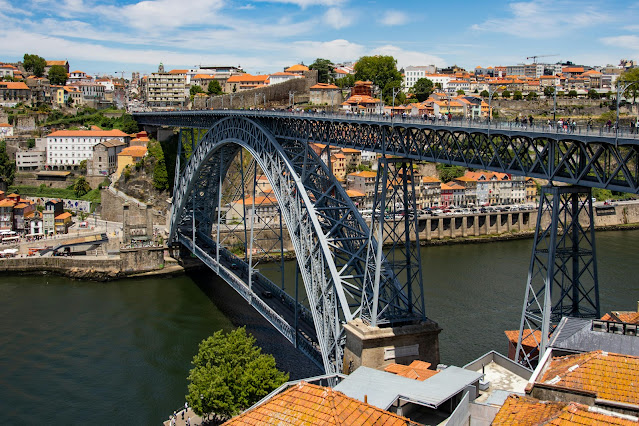Portugal is a small nation on the Iberian Peninsula that faces the Atlantic Ocean. It is one of the most traveled countries in Europe due to its stunning coastline and rich historical legacy. Compared to neighboring Spain, for example, it is easier to travel around and see more locations in a given length of time due to its smaller size.
Travelers can view Roman and Moorish remains among other tourist attractions in Portugal because of the region's mild temperature, which makes it an ideal destination for year-round travel.
List of Top Tourist Attractions in Portugal
Pena National Palace:
On cloudy days, the Pena National Palace appears to be a castle out of a fairy tale. Still, on a clear day, Lisbon can see it from atop a hill in Sintra.
Built by King Ferdinand II, it is a striking example of 19th-century Romanticism in Portugal and around the globe, fusing Manueline and Moorish architectural elements. Originally built as a chapel dedicated to Our Lady of Pena in the Middle Ages, it is currently utilized for state functions.
Belem Tower:
Lisbon, the capital of Portugal, is home to Belem Tower, also called the Tower of St. Vincent, which is situated on what was formerly an island in the Tagus River. The tower, which dates back to 1515, was constructed to welcome friends to Lisbon as well as to protect it from attackers.
Constructed during the Age of Discovery, the four-story limestone tower was linked to a bastion that could accommodate seventeen long-range cannons. Facing the river is a statue of Our Lady of Safe Homecoming, who was created to guard sailors on their travels.
Related article: Beautiful Islands in Portugal.
Praia da Marinha:
Praia do Marinha is regarded as one of Portugal's most exquisite beaches. The beach, which is part of the Algarve's Atlantic coast region, is surrounded on one side by stunning blue waters and on the other by cliffs and sandy beaches.
This little cove, sometimes called Navy Beach, is frequently included as an image in vacation brochures. The beach is a fantastic spot for snorkeling because of its pristine waters. Albuferia is roughly a 30-minute drive away from this charming beach, which offers free parking.
Cais da Ribeira:
Cais da Ribeira is a quaint, attractive neighborhood of Porto that is frequently called "the soul of Porto." It consists of streets from the Middle Ages that come to a square beside the Douro River. Ribeira is a well-liked spot for dining and drinking because of its abundance of restaurants, taverns, and cafes housed in medieval architecture.
Ribeira is particularly well-liked on feast days when the locals swarm there to watch the fireworks. In the center of the square is a metal cube. The residence where Prince Henry the Navigator was born in 1394 is not far away.
Obidos Castle:
Situated atop a hill in Obidos, a small city on Portugal's Atlantic coast that was home to Roman settlers, is the striking Obidos Castle. The castle was constructed by the Moors in the seventh century.
A keep was added while it underwent renovations in the fourteenth century. The castle is now home to an opulent pousada hotel. Every July, a genuine medieval market is held in the castle.
Sao Jorge Castle:
With its panoramic views of the entire city, the São Jorge Castle is one of Lisbon's most popular tourist destinations. Although the Moors erected the defenses in the tenth century, the structure dates back to the Roman era. In 1147, the castle was liberated from Moorish domination amid the Second Crusade's Siege of Lisbon.
Alfonso III thereafter lived there as his official residence. Several times, the castle has been demolished and then rebuilt. There are still 18 climbable towers and walls in place today.
Cabo Girao:
Cabo Girão is situated in the Portuguese archipelago of the same name, on the southern coast of Madeira. Although there are at least three European cliffs that are higher, the 570-meter (1,870-foot) cliff is frequently referred to as the tallest sea cliff in Europe.
Despite everything, the vista of the very steep drop to the ocean is exhilarating. A platform with a glass floor was added in 2012, making for an even more terrifying viewing experience.
Capela dos Ossos:
Although the Capela dos Ossos looks like something from a Halloween movie, it was a straightforward solution developed by monks in the 16th century to address the issue of too many graves taking up valuable real estate in Evora.
The human remains were relocated to a unique chapel called Bone Chapel, which has decorations made of bones throughout. The Gothic Church of St. Francis includes the chapel. An estimated 5,000 skeletons, including skulls, are painted on the chapel's roof and walls.
University of Coimbra:
Founded in 1290, the University of Coimbra is among the oldest continuously operating universities in Europe. With almost 20,000 students, it's also one of Portugal's biggest universities. The university complex has a lot of interesting areas.
King Joao V ordered the library Biblioteca Joanina to be built in the early 1700s, and it is a magnificent example of Baroque architecture. The doctorates are given out in the Sala dos Capelos, the original throne room.
Alcobaca Monastery:
The village of Alcobaça, in central Portugal, is home to the Roman Catholic Monastery known as the Alcobaça Monastery. It was established in 1153 by Afonso Henriques, the first Portuguese king, and throughout its history, it remained closely associated with the Portuguese kings.
Along with the Monastery of Santa Cruz in Coimbra, the church and monastery were among the most significant of Portugal's medieval monasteries. They were the country's earliest Gothic structures.



